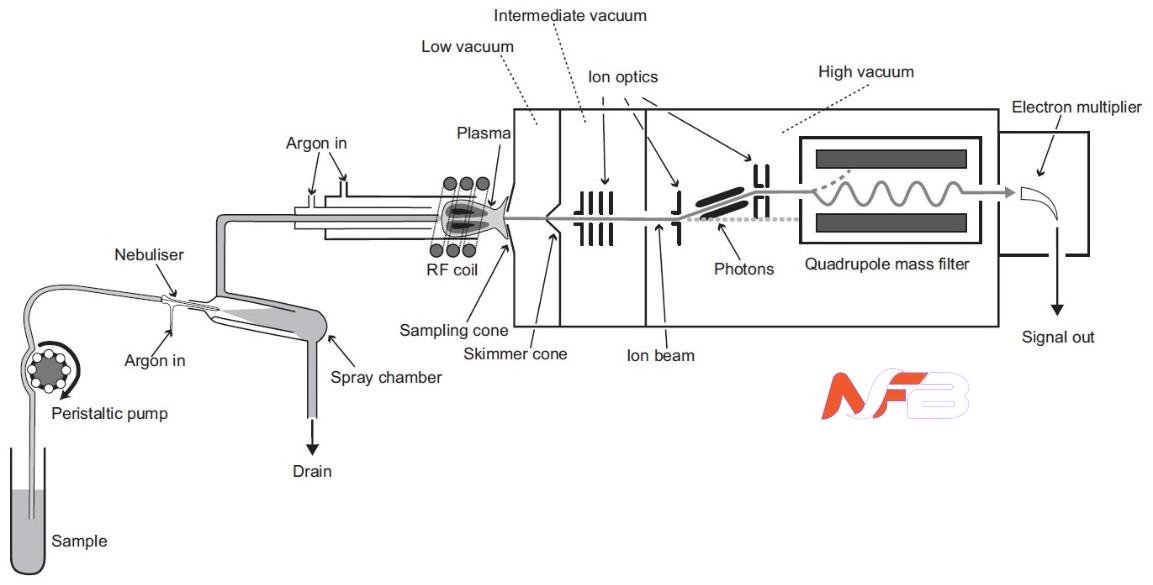Inductively Coupled Plasma Mass Spectrometry (ICP-MS) is an effective analytical method for detecting trace elements and isotopes in diverse materials. It combines the high-temperature ionisation capabilities of an inductively coupled plasma with mass spectrometry’s accuracy and sensitivity. This approach is highly recognized in scientific domains because of its capacity to identify even trace amounts of components, making it perfect for environmental, clinical, industrial, and food safety monitoring. ICP-MS produces accurate, consistent findings, making it an indispensable tool for academics and enterprises that require precise elemental analysis.
What is ICP-MS?
ICP-MS stands for Inductively Coupled Plasma Mass Spectrometry, a method for determining the chemical composition of components in a sample. It involves ionizing a sample with a high-temperature plasma, which is subsequently examined by a mass spectrometer. The approach is extremely sensitive, allowing for the detection of tiny amounts of metals and other elements in complicated matrices. ICP-MS can examine a wide range of elements, including lithium and uranium, and is especially useful for identifying tiny levels of elements in environmental, biological, and industrial samples. It is often used to determine the concentration of elements, identify unknown chemicals, and give elemental mapping in various matrices. ICP-MS, which combines plasma ionization with mass spectrometric detection, provides very accurate, multi-elemental analysis, making it a vital tool in many scientific and industrial applications.
What is ICP-MS Used For?
Environmental and Water Testing Applications
ICP-MS is widely used in environmental and water monitoring because it can identify trace metals and pollutants in water samples. This involves monitoring heavy metals such as lead, mercury, and arsenic, which are hazardous to both human health and the environment. It allows for reliable examination of water quality, assuring compliance with safety regulations. ICP-MS can analyze surface and groundwater samples and detect contaminants at extremely low concentrations. As a result, this technology is crucial for environmental monitoring, pollution management, and the provision of clean drinking water across the world.
Clinical and Pharmaceutical Analysis
In clinical and pharmaceutical analysis, ICP-MS is used to determine the elemental composition of biological samples such as blood, urine, and tissues. This aids in detecting the presence of hazardous metals or deficits in critical trace elements. The approach is also used in medication formulation to ensure that pharmaceutical goods are free of potentially hazardous impurities. Heavy metals may be identified in pharmaceuticals and medical devices using ICP-MS, which helps to satisfy severe safety criteria. Its sensitivity enables the identification of constituents at trace quantities, making it a vital tool in clinical diagnostics and pharmaceutical research.
Industrial and Food Safety Testing
ICP-MS is a valuable tool in industrial and food safety testing because it detects dangerous metals and pollutants in food goods, drinks, and industrial materials. It may detect metals like cadmium, lead, and mercury that may be present in food owing to environmental exposure or industrial procedures. In the food business, ICP-MS helps guarantee that goods satisfy safety requirements and reduces the danger of contamination. In industrial applications, it is used to assess raw materials and final products to guarantee that they are free of harmful substances, protecting both customers and workers.
How Does ICP-MS Work?
The Sample Introduction and Ionization Process
ICP-MS begins with the introduction of a sample into the system, which is then atomized and ionized in an inductively coupled plasma. The plasma, a highly energetic state of matter, is formed by passing a gas, usually argon, through a magnetic field, causing it to ionize. This procedure converts the material into charged particles, or ions, which are subsequently sent into the mass spectrometer. The plasma’s high temperature guarantees that all elements in the sample are completely ionized, making them easier to evaluate with great sensitivity.
Role of the Mass Spectrometer in Detection
After ionization, the ions are sent into the mass spectrometer, where they are separated by a magnetic and electric field based on their mass-to-charge ratio. The mass spectrometer detects and analyzes the quantity of each ion, resulting in a spectrum that identifies the elements in the sample. This method enables ICP-MS to precisely measure the concentration of various elements, even at trace levels. The capacity to separate ions based on mass allows the technology to examine complicated mixtures and produce unambiguous, different findings for each element in the sample.
Data Analysis and Quantification Techniques
After the ions are identified, the data is evaluated with specialized software, which translates the mass spectrum into useful information. The program compares the strengths of the ion peaks to calibration standards to determine the concentration of each element. Calibration curves are created using known standards, and the program uses mathematical algorithms to adjust for environmental noise and interference. This enables very precise quantification of constituents, even in complicated matrices. The precision and sensitivity of ICP-MS ensure that the data obtained is reliable and can be used for various applications, including compliance testing and scientific research.
Conclusion
ICP-MS is a sophisticated analytical technology that offers unparalleled sensitivity and precision for elemental analysis in a variety of applications. Its capacity to identify trace elements and isotopes with great precision makes it ideal for environmental monitoring, clinical diagnostics, pharmaceutical research, and industrial testing. Understanding how ICP-MS works, from sample introduction to data processing, demonstrates why it is one of the most used methods for elemental analysis today. As technology advances, ICP-MS will continue to play an important role in guaranteeing product safety, compliance, and quality in a variety of industries.














Leave a Reply